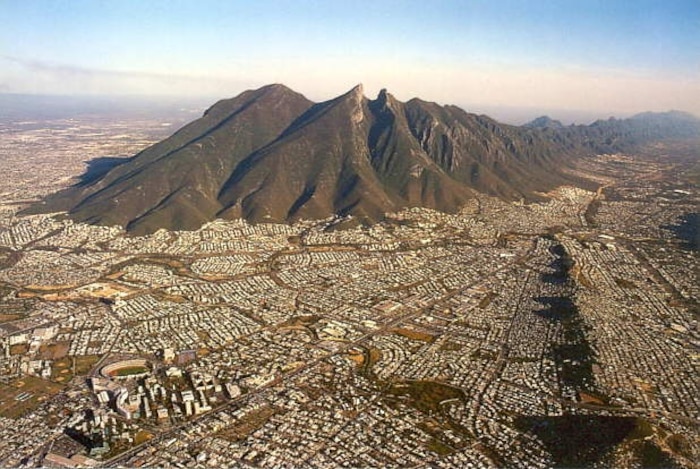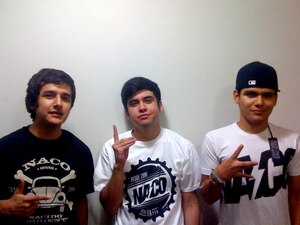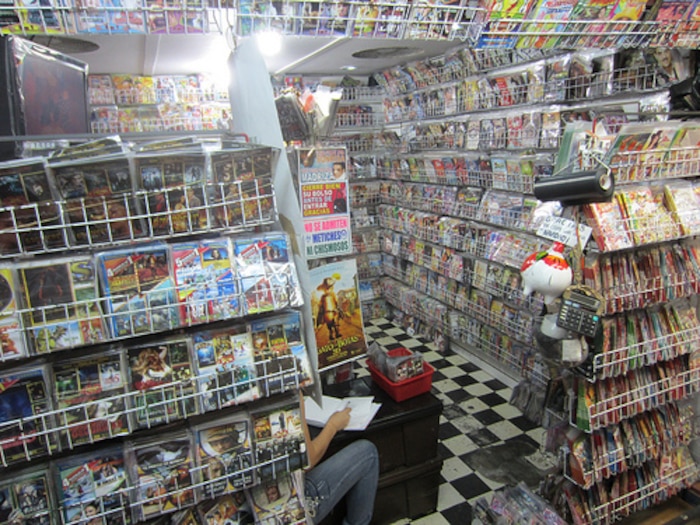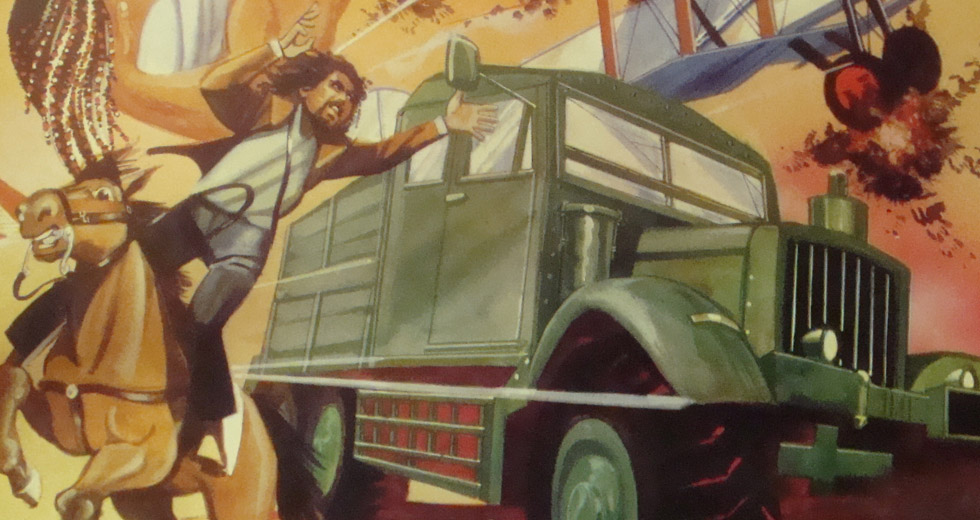Interview: Toy Selectah
Dublab’s Frosty sits down with Mexico’s iconic DJ, producer and former Academy lecturer Toy Selectah to talk on the tribal sound, the importance of piracy, pointy boots and the occasionally risky Monterrey climate

Tribal guarachero, or simply 'tribal', is one of a multitude of fusion dance hybrids that have emerged in a universe of ever-splintering microgenres. It flies high with a 132 BPM triplet swing that seems to cruise much slower, due to the cumbia shuffle that often forms its base. The original blueprint was pioneered by Mexico City’s Ricardo Reyna, DJ Mouse and others, whose dancefloor creations frequently featured pre-Hispanic sound samples embedded in an electronic dance foundation. These ancient elements earned their music the tribal moniker.
While the producers in Mexico's Distrito Federal originated the tribal sound, those in Monterrey – in northeastern Mexico – gave it a flavour that helped it rise. Monterrey has enjoyed a long love affair with cumbia, so it’s natural that it would embrace its offspring as well. Colombian records started flowing into the city in the 1960s and 70s via the well-oiled distribution channels of labels like Discos Fuentes. The people of Monterrey voraciously consumed this music, and flipped it to make it their own. Monterrey’s Celso Piña, inspired by Colombian artists such as Anibal Velasquez, used his accordion to create a uniquely Mexican brand of cumbia that fused tropical tones with a norteño sound. Today, you can cruise to Monterrey’s tianguis (open-air markets) and find vendors selling MP3 CDs crammed with hundreds of low bit-rate cumbias, as well as some surprises in between.

It was in one of these flea market stalls that Monterrey producer Antonio ‘Toy Selectah’ Hernandez discovered 3Ball MTY. Toy is no stranger to taking specialised sounds to wide audiences. His group Control Machete was one of the first homegrown Mexican hip hop groups to achieve major success. In 2001, Toy collaborated with Piña to make “Cumbia Sobre El Rio”, a Latin Grammy-nominated crossover hit. From 2004-2007, he continued his mission of musical development in an A&R role for Universal Music, helping reggaeton and other distinctly Latin American sounds spread across the world. Armed with this industry experience and natural instincts, he sensed something special in 3Ball MTY. Antonio enthusiastically shared the discovery with pals like Chico Sonido, who remembers getting turned onto tribal sounds: “It was like discovering diamonds in the rough. They were already diamonds, but they were underground.”
The original 3Ball MTY tunes were highly inspired, raw creations. As Chico tells us, “It’s the product of a generation that grew up with PCs and have lots of time on their hands. Using FruityLoops, they sample from real crazy underground: Mexican producer libraries fusing reggaeton rhythms, cumbia loops and random sounds. They like to get a lot from the internet, from YouTube. They build their own sound libraries and share them.” The producers would distribute their songs freely on file-sharing sites, and play them at Sunday afternoon teen parties and quinceañeras in Monterrey.

For many, this unpolished stage of the genre was the most attractive, but proto-forms rarely find mainstream success. With the big picture in mind, Toy brought 3Ball MTY’s Erick Rincon, DJ Sheeqo Beat and DJ Otto into the studio to produce an album primed for commercial success. The resulting songs were professionally recorded, and featured collaborations with established Mexican vocalists. This gamble on a glossy makeover of an unestablished genre seems to have worked. 3Ball MTY’s single and album of the same title, Inténtalo can now be heard across Mexican television, radio broadcasts, flashy clubs, taxi cabs and wedding dancefloors. Toy predicts the tribal sound will have a long life similar to that of reggaeton, another genre he helped foster.
3Ball MTY’s success is a testament to Toy’s musical intuition and his experience navigating the Latin American music industry. He keeps his feet firmly planted in the underground world while steering things from the top. Like his friend Diplo, who released Toy Selectah’s Mex Machine EP on Mad Decent, he is a sound explorer who blots out borders. He’s drafting an alternative map for a world that flows freely with previously unknown tropical rhythm and bass.
Are you originally from Monterrey?
Yes, I’ve been living here all my life, with periods in-between in the last ten, 15 years spent in Mexico City, Los Angeles or London, but basically living in Monterrey. I was born here in 1976 so I’m 36 years old now.
Control Machete rose to fame before the internet became a real game changer in sharing music with the world. Do you think that this hard-earned success has helped give you an edge today?
It definitely made something happen to my way of thinking and my experiences. After more than 15 years of working very consistently and trying to push forward limits of fusion with this particular point of view of being a Mexican, world traveller – very funky-ass, but at the end a Mexican – with a different vision from being on the other side of the border. So, I think that shapes some particular assets. I’m always remembering, I’m always thinking how we lived. Actually it was too fast and I was too young, but the fun part of it is to think that I’m now seeing the young Monterrey kids at that particular age, and I’m seeing it from the top of the hill. I’ve always told them, “Hey I’ve been there and done that, that same way. So, you know, keep going, be focused.”
I’m always very grateful and give thanks to the cosmos, that I had the opportunity to live a story like the Control Machete one, being the first real kind of Mexican hip hop outfit out there, and getting into the charts and the radio and to the masses and to music videos. It was a particularly nice time, a nice alternative MTV Latino time, when MTV served as the window for the exchange and exposure of alternative music from all around Latin America. From Argentina, all the way to the north of Mexico, to Tijuana, Monterrey, through Mexico City and every region in between. That experience definitely reflects an edge that’s present in who I am right now.
Tell us about Sistema Local. What’s the mission? How has this posse helped your sound develop?
Wow, Sistema Local! We were really active between 2006-07. Not that I’m saying that it’s over now, but through the years we’ve been developing a very interesting number of wide situations: from extreme street sports, like long-boarding, to albums, to Chico Sonido being a key player in the development of today’s underground LA scene around Freak City. Ariel has been really focused on opening a very alternative store here in downtown Monterrey. So, I think about the idea that we got together and put the seeds into the ground for a lot of things that happened after. Like in music styles, with the whole combination of cumbia sounds with hip hop and Jamaican sounds, since the very early stage. Think about Sistema Local releasing in early 2006 one of the first new cumbia, or whatever you want to call it, 12"s of mash-ups, outtakes and extended takes of stuff. It’s been very interesting, a very nice collective of people that don’t take it as something to sell, but just as a state of mind. It’s something that’s created the base for what all of us have made happen since then.
Your music is a mixture of lots of influences. Have you always been a sonic explorer? How do you discover the music that moves you?
I consider myself an explorer before a player or a DJ. I discovered who I am when I discovered the three band equalizer of the stereo, at home back in the early 80s. When I discovered the records that were at home, I started looking for the craziest stuff to put together for family parties and stuff like that. Definitely, that’s how I discovered the music that moves me. The fact that fading through frequencies can make you feel emotions. That’s it!
You’ve been able to evolve and float across genre lines. What’s your secret to staying ahead of the curve?
Wow, being real and always being aware of what’s going on in the streets. Looking for it and being, curioso, like curious, about stuff. I read a lot. I like to read stories about the history of recorded music: record labels, producers. I just read Nile Rodgers’s biography. I don’t know, looking for stuff, reading, tracing connections, looking for questions, looking at production credits, buying records, buying music, understanding why things sound the way they sound because they come from certain places or certain eras. Knowing the past to manipulate the future… wow, that’s it!
I discovered who I am when I discovered the three band equalizer of the stereo...
Diplo released your Mex Machine EP on his Mad Decent label. How did you connect with him?
I met Wes [Diplo] back in 2005, I think. I met him at the SummerStage in Central Park when MIA played. So, Diplo was DJing Maya’s show and he was playing music before the concert. He was playing Tego Calderón and some crazy rhythms, dancehall, mash-ups and stuff like that. He mixed some Latin stuff. I was not dissing him before that, because, I mean, Hollertronix was tough and this whole kind of B-more/Philadelphia thing, and that MIA mix-tape that I got crazy with. Back in the day, I was doing A&R jobs for Universal Music’s Latino Division and I was there in Central Park for that event with Mr Vegas and his entourage. Mr Vegas back in the day was working with some reggaeton rhythms. So, after the show we ended up back at Diplo and Maya’s apartment in New York City. They ended up recording this version Mr. Vegas dropped on [New Order’s] “Blue Monday” that then became a part of MIA’s second album. It was a reinterpretation of “Blue Monday” with a kind of Jamaican rhythm.
So, since then we stayed in touch. I left him with a lot of music on his hard drive, reggaeton sound library stuff. So, he suddenly called me, like, “You left me some good stuff here man. Let’s keep talking. What’s going on?” So, then he went to Mexico City, I think for the first time or second time, and we spent two days in Mexico City DJing, flea marketing and just being there and hanging out. During that trip he told me about kuduro and Buraka Som Sistema and I told him about cumbia and Colombia and everything. Then he went to Argentina to play at ZZK Party and all this huge cumbia stuff was happening and the baile funk situation, he was really into that, back then. So, we’ve stayed in a good relationship and we meet every time we can. I gave him some remix assignments for the label I was working on. He remixed Don Omar and he remixed Wisin y Yandel. Back then, way before moombahton, we were exploring dembow on 110 with that type of post-futuristic dancehall thing. That’s why I respect Wes. I mean, what he is doing right now, is what we were doing, I don’t know, like seven years ago, but you know, it’s today. It’s not that I’m saying we were doing the same seven years ago but it’s all connected. I support him, I respect him, we are good friends.
You’ve championed and produced the tribal group 3Ball MTY who made the now mega-hit crossover tune “Inténtalo”. What initially impressed you about them?
I found their music real chaotic, junk, fresh, fearless, unorthodox, rule-breakers. Completely legit but illegitimate at the same time, but that’s how this era is. It’s a complete catharsis of everything, back and forth, of present, past and future.
How big is tribal in Mexico? Is it really being listened to widely or just an internet, youth buzz? Do you think the sounds will mature and have some longevity?
Yeah, man the tribal sound and Tribal Monterrey particularly is the now music. It’s huge, man. It’s a complete sensation and phenomenon right now. It’s not just internet awareness. Right now it’s in mainstream media: TV outlets, music outlets, radio. It’s even in commercial campaigns already, not just in Mexico but in the US, too. It’s definitely the hottest new sound for the youth right now. It’s not just for the Mexicans, man, but South America is really getting into it, Central America and now on the east coast Puerto Ricans, Dominicans, New Yorkers and Miami is really into it. I think it’s because it’s organic, drum-oriented, electronic, youth, emo – and I’m saying emo because of the emotion in the music. So, I think it’s got longevity because it’s building a fan base. They opened for Justin Bieber, man, like a month ago in Mexico City, in front of like 200,000 people. Even though lots of Beliebers, lots of people who were there didn’t know about them, I think now they know and they will grow up and walk with them in the next five or ten years. I’m pretty sure that it’s a generational thing right now.
I heard 3Ball MTY’s hit “Inténtalo” played at a wedding in Guadalajara recently. It must a great sign of success for a band’s song to become a Mexican wedding standard.
“Inténtalo” is a hit, a worldwide hit. Today we just got the video from this Iranian singer that asked for permission, like two months ago, to make a version in Farsi. That means it’s a big hit. It’s definitely a wedding standard, ha! Think about “Inténtalo” as what “Gasolina” was for reggaeton, I think that’s what “Inténtalo” will be for tribal. Think about the fact that “Gasolina” is from 2004, and we are in 2012. There’s been almost ten years of reggaeton and it’s still big! So, you know, this is just the beginning.
Tell us about pointy boots. Do you see people wearing these in the streets or is it just a media phenomenon. (On a side note, I'd like to see an all pointy boot football league.)
Ha ha! We don’t have any relation with the pointy boots thing at all, ha ha. It was just like a fashion thing that happened 400km from Monterrey in a city called Matehuala, but at the same time lot of Matehuala people immigrate to Texas so the fashion happens on both sides of the border. It was just a reflection, or an answer to the music that Tribal Monterey in particular has been doing for the past three or four years. It was kind of this futuristic, rancho, cowboy, no-limit music but it’s a funny thing. There are definitely not pointy-booters around in the streets but it’s a trend that looks tremendously good in clubs or in places that people go to dance. Think about platforms and stuff like that from the 70’s in the disco era.

What’s your outlook on the rampant music piracy on the street level in Mexico? Has this helped independent artists reach new audiences or hurt their growth?
Piracy is changing music. The internet or flea market piracy and stuff like that always helps music to explode and to get to the next biggest circles of not just certain scenes or certain segments of the public or market but wider. Let’s think about tribal. I found out about the Tribal Monterrey kids through pirate CDs in the flea markets. Last year, before 3Ball MTY’s “Inténtalo” went into the charts it was through pirated CDs compiling the YouTube hits of last fall. Flea market MP3 CDs with tons, like hundreds, of MP3 tracks per CD. “Inténtalo” was there and it was a straight internet, pirated hit before it went crazy in the regular media. So, I think it’s just a matter of process and dynamic in how music is being developed and how music reaches the people right now.
Monterrey has been gripped with some of the worst of the drug violence in Mexico. Give us a glimpse into daily life in Monterrey. What things are people doing to keep their chins up?
I would recommend you read an article that Billboard Magazine just posted about the murders. It’s very interesting. Definitely the dynamics of entertainment, nightclubs and stuff, in Monterrey has changed a lot in the last three years. I’m a positive guy. I hope things will change soon and will be better, but for a certain point of view read that article.
What’s the current post-election climate in Mexico? What’s the general reaction amongst the creative community to the return of the PRI party?
Politically, in México we are living in crazy times. Nothing is completely settled yet. The election has not been declared won. I am a lefty guy. I voted for Andrés Manuel Lopéz de Obrador. I really believe that there were lots of irregularities in the election. I hope that for the sake of good they will take care of that. I’m really not happy about the idea of getting the PRI back. I fought, I did. I worked a lot against that but it seems like they took control of lots of things. The involvement of the young people, of the youth, it was crucial. You should keep looking into what’s going on here.
What’s your dream of a future Mexico?
My dream for a future Mexico is to have equal opportunities for everybody. Actually, I think for a future, America as a continent or North America – no borders man! I really believe that that border will be used less in the future because we will be the same culture, each side of the border, if it’s not already that.

